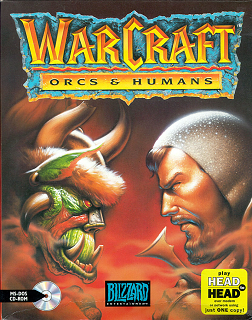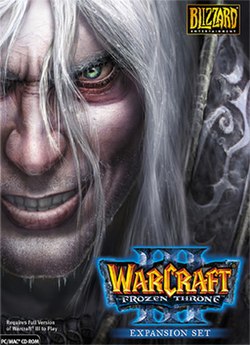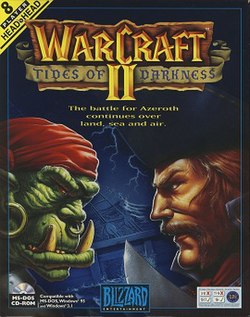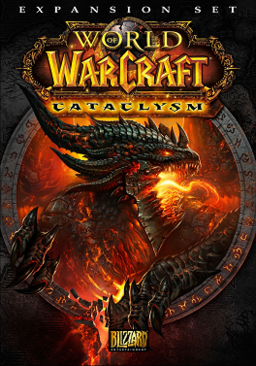IT ALL STARTED IN THE BEGINNING

Warcraft is a franchise of video games, novels, and other media originally created by Blizzard Entertainment. The series is made up of four core games: Warcraft: Orcs & Humans, Warcraft II: Tides of Darkness, Warcraft III: Reign of Chaos, and World of Warcraft. The first three of these core games are in the real-time strategy genre, where opposing players command virtual armies in battle against each other or a computer-controlled enemy. The last and best selling title of the franchise is a massively multiplayer online role-playing game (MMORPG). Expansion sets were also released for multiple games in the series, each adding more content to each game as an effort to expand the product lifespan of each. No expansions were released for Warcraft: Orcs & Humans. Warcraft II was accompanied by the release of Warcraft II: Beyond the Dark Portal. Warcraft III was accompanied by the release of Warcraft III: The Frozen Throne. Multiple expansion packages accompanied World of Warcraft, namely The Burning Crusade, Wrath of the Lich King, Cataclysm, and Mists of Pandaria.
All games in the series have been set in and around the world of Azeroth, a high fantasy setting. Initially, the start of the series focused on the human nations which make up the Eastern Kingdoms, and the Orcish Horde which arrived in Azeroth via a dark portal, beginning the great wars. The Orcs arrived from another world, referred to as Draenor or Outland, a world which will be shattered into pieces by demonic magics during the events of Warcraft II. Later on in the series the world of Azeroth was expanded, revealing the new continents of Kalimdor, Northrend and Pandaria, allowing the introduction of the Night Elves, Tauren and other major races into the universe. The world of Azeroth also contains the traditionalfantasy setting races of elves, dwarves, gnomes, orcs, and trolls.
The series also resulted in the publishing of several books relevant to the Warcraft universe setting, covering a wide range of the timelines of the universe. A collectable card game was also published, which offered those who bought booster packs a chance to gain access codes to limited in-game content in World of Warcraft. An upcoming film adaptation is planned. A number of comics have also been released alongside the books, further covering parts of the universe's storyline. A short-lived, online-subscription only magazine was also available, but later ceased publication after just 5 issues

Warcraft: Orcs & Humans is a real-time strategy game (RTS), developed by Blizzard Entertainment and published by Blizzard and Interplay Entertainment. The MS-DOS version was released in November 1994 and the Macintosh version in late 1996. Sales were fairly high, reviewers were mostly impressed, and the game won three awards and was a finalist for three others. There was a CD re-release, namely version 1.21 (CD version), that didn't have the word-from-the-user-manual copy protection of prior versions. The sequel, Warcraft II: Tides of Darkness, became the main rival to Westwood Studios' Command & Conquer series, and this competition fostered an RTS boom in the mid to late 1990s.
Although Warcraft: Orcs & Humans was not the first RTS title to offer multiplayer games, Blizzard's game persuaded a wider audience that multiplayer facilities were essential for future RTS titles. The game introduced innovations in mission design and gameplay elements, which were adopted by other RTS developers.
Blizzards's main emphases in these games were on skillful management of relatively small forces and on development of characterization and storyline within and between games played in the same universe.
Warcraft II: Tides of Darkness is a fantasy-themed real-time strategy (RTS) game published by Blizzard Entertainment and first released for DOSin 1995 and for Mac OS in 1996. The main game, Warcraft II: Tides of Darkness, earned enthusiastic reviews, won most of the major PC gaming awards in 1996, and sold over 2 million copies.
Players must collect resources, and produce buildings and units in order to defeat an opponent in combat on the ground, in the air and in some maps at sea. The more advanced combat units are produced at the same buildings as the basic units but also need the assistance of other buildings, or must be produced at buildings that have prerequisite buildings. The majority of the main screen shows the part of the territory on which the gamer is currently operating, and the minimap can select another location to appear in the larger display. The fog of war completely hides all territory which the gamer's has not explored, and shows only terrain but hides opponents' units and buildings if none of the gamer's units are present.
Warcraft II 's predecessor Warcraft: Orcs & Humans, released in 1994, gained good reviews, collected three awards and was a finalist for three others, and achieved solid commercial success. The game was the first typical RTS to be presented in a medieval setting and, by bringingmultiplayer facilities to a wider audience, made this mode essential for future RTS titles. Warcraft: Orcs & Humans laid the ground for Blizzard's style of RTS, which emphasized personality and storyline. Although Blizzard's very successful StarCraft, first released in 1998, was set in a different universe, it was very similar to Warcraft II in gameplay and in attention to personality and storyline. In 1996 Blizzard announced Warcraft Adventures: Lord of the Clans, an adventure game in the Warcraft universe, but canceled the game in 1998. Warcraft III: Reign of Chaos, released in 2002, used parts of Warcraft Adventures' characters and storyline and extended the gameplay used in Warcraft II.

The plot of Beyond the Dark Portal takes place after the events of Warcraft II: Tides of Darkness. The Orcs, now under the leadership of Ner'zhul, staged a new invasion of Azeroth and overwhelmed the citadel of Nethergarde, which guarded the remnants of the portal. The Alliance itself had been splintered after the Second War and Gilneas and Stromgarde had withdrawn their support. The arch-mage Khadgar summoned heroes of Azeroth, Alleria Windrunner, Danath Trollbane, Turalyon and Kurdran Wildhammer to rally the forces of the Alliance. The Horde was beaten back and Khadgar decided to take the initiative to push through the Portal into the Orcs' homeland. Before being pushed back, Ner'zhul managed to steal the spellbook of Medivh which was needed to create new Portals.
The Alliance gained a foothold and made preparations to seal the rift forever while the Orcs reorganized. Khadgar needed the spellbook of Medivh and the Skull of Gul'dan to accomplish it. They razed the Shadowmoon Citadel, seat of Ner'zhul's Shadow Council. While the Alliance army and navy only barely held out, Khadgar managed to acquire the items with help from the Laughing Skull Clan. Ner'zhul managed to open portals to the Twisting Nether and escaped through one of the new Portals. The violent energies began to destroy Draenor and also threatened Azeroth. Khadgar destroyed the Portal on the side of Draenor to prevent harm to Azeroth, trapping the remaining Alliance forces beyond the Dark Portal in the dying land of Draenor. Khadgar and the warriors of Azeroth then entered one of the portals not knowing where it would lead to avoid being killed by the violent rifts tearing the planet apart. With the release of World of Warcraft: The Burning Crusade, it is revealed that the Alliance forces actually remained on Draenor rather than escaping through a portal as said in Beyond the Dark Portal's ending. They are still alive and are currently fighting to prevent another invasion of Azeroth

Warcraft III contains four playable races: Humans and Orcs, which had previously appeared in Warcraft: Orcs & Humans and Warcraft II: Tides of Darkness, and the Night Elves and Undead, which were introduced to the Warcraft mythos in this installment. Warcraft III's single-player campaign is laid out similarly to that of StarCraft (another Blizzard game), being told through all four of the game's races in a progressive manner. In the expansion there are two additional races: the Draenei, a race of eredar who are cursed to be abominations, and the Naga, a race of vile serpents and other creatures that come from the depths of the sea. Multiplayer mode allows for play against other people, via the internet, instead of playing against computer-controlled characters as is done in the single-player custom game mode. Due to the dual storylines of the previous Warcraft games, the story can only be understood if using the proper storylines of one of the campaigns in the previous games, being the Orc Campaign on Warcraft: Orcs & Humans and the Human Campaigns on both the Warcraft II: Tides of Darkness and Warcraft II: Beyond the Dark Portal.
The game proved to be a best seller and one of the most anticipated and popular computer game releases ever, with 4.5 million units shipped to retail stores and over one million units sold within a month. Warcraft III won many awards including "Game of the Year" from more than six different publications

Warcraft III: The Frozen Throne is a real-time strategy computer game developed for Microsoft Windows, Mac OS and Mac OS X by Blizzard Entertainment. It is the official expansion pack to Warcraft III: Reign of Chaos, requiring Reign of Chaos to play. Released in stores worldwide in multiple languages beginning on July 1, 2003, it includes new units for each race, two new auxiliary races, four campaigns, five neutral heroes (an additional neutral hero was added April 2004 and two more were added in August 2004), the ability to build a shop and various other improvements such as the ability to queue upgrades. Sea units were reintroduced; they had been present in Warcraft II but were absent in Reign of Chaos. Blizzard Entertainment has released patches for the game to fix bugs, add new features, and balance multiplayer.
THE WORLD OF WARCRAFT PHENOMENON HAS BEGUN
The first expansion set of the game, The Burning Crusade, was released on January 16, 2007. The second expansion set, Wrath of the Lich King, was released on November 13, 2008. The third expansion set, Cataclysm, was released on December 7, 2010. On October 21, 2011, the fourth expansion set of the game, Mists of Pandaria, was announced at BlizzCon 2011 by Chris Metzen.
With 10.2 million subscribers as of December 2011, World of Warcraft is currently the world's most-subscribed MMORPG, and holds theGuinness World Record for the most popular MMORPG by subscribers


World of Warcraft: The Burning Crusade, often referred to as TBC or BC, is the first expansion pack for the MMORPG World of Warcraft. It was released on January 16, 2007 at midnight in Europe and North America, and sold nearly 2.4 million copies that day to people who waited over night in long lines to get the expansion, making it the fastest-selling PC game in those regions. It was released on January 17, 2007 in Australia and New Zealand; in total, approximately 3.53 million copies were sold across these territories in the first month of release, including 1.9 million in North America, over 100,000 copies in Australasia, and nearly 1.6 million in Europe. It was also released in Singapore, Thailand, and Malaysia on January 16, 2007. It was later released in South Korea on February 1, 2007; in Taiwan, Hong Kong, and Macau on April 30, 2007. The game was released in China on September 6, 2007. On June 28, 2011, Blizzard released the game for free to all users who purchased the original game

World of Warcraft: Wrath of the Lich King, often referred to as WotLK, WLK or Wrath, is the second expansion set for the massively multiplayer online role-playing game (MMORPG) World of Warcraft, following The Burning Crusade. It adds a substantial amount of content to the game world, including the continent of Northrend, home of the eponymous Lich King, and a new character "hero" class. It was announced on the first day of BlizzCon 2007, August 3, 2007.
Wrath of the Lich King was released on November 13, 2008, selling 2.8 million copies within the first 24 hours of availability. This made it the fastest selling computer game of all time, beating the record set by the previous World of Warcraft expansion The Burning Crusade, which sold 2.4 million within its first 24 hours. It later lost its rank as number one after the third expansion set, World of Warcraft: Cataclysm, which was released on December 7, 2010, and had sold over 3.3 million copies within its first 24 hours on the market
Shortly after the announcement of the release date, on October 12, 2010, Blizzard implemented patch 4.0.1, which included the overhaul of the game's playing systems
AND THE LAST ONE BLIZZARD RELEASES

World of Warcraft: Mists of Pandaria is the fourth World of Warcraft expansion pack. It was announced on October 21, 2011 by Chris Metzen at BlizzCon 2011. On March 21, 2012 the expansion entered a closed beta test.Mists of Pandaria will raise the existing level cap from level 85 to 90. It will introduce a new character class, the Monk, along with a new playable race, the Pandaren. The vanity pet system will be overhauled and will include a pet battle system. New PVE scenarios will be introduced, and Challenge Modes will be added for dungeons. The existing 41-point talent trees will be replaced by a new system of tiered talents that are awarded every 15 levels. Blizzard has stated that there are plans for nine new dungeons, three new raids, and four new battlegroundsThe game is set after the events of Deathwing and the Cataclysm. The major setting is the titular land of Pandaria, one of the continents of the world of Azeroth. Discovery of Pandaria is made after a naval battle between the Horde and the Alliance. It had previously been hidden by magic since The Sundering, only to resurface
Pandaria
Pandaria is a new continent located to the south of the Eastern Kingdoms and Kalimdor. Several zones have been announced, including the Jade Forest, Valley of the Four Winds, Vale of Eternal Blossoms, Townlong Steppes, Kun-Lai Summit, Krasarang Wilds, and the Dread Wastes. The Jade Forest will be the first zone, and the entry point for the Alliance and Horde. It will feature lush rainforest and stone spires, and introduce the player to the Hozu and Jinyu races. It will contain the Temple of the Jade Serpent, one of the new dungeons, and introduce the Sha enemy. The Valley of the Four Winds will include Pandaren farm lands, with a coastal jungle. The Stormstout Brewery, another new dungeon, is located in the valley
Monk class
Monks use an energy source to power basic abilities like Jab.
The basic Jab attack is used to generate a resource called "Chi", which are then used for more advanced attacks. The monk class was originally not going to utilize an auto-attack like the other classes, but as of the 2012 MoP Press Event, they have been given an auto-attack. The monk class has three specializations known as: Brewmaster (tanking), Windwalker (melee damage), and Mistweaver (healing). Some details of the healing specialization have included that it will heal through "proximity" based heals, by dropping statues, similar to a shaman totem, that pulse healing as they perform attacks on the enemy target. Blizzard announced that choosing the healing specialization will give the monk a mana bar like other healers. Monks will wear the leather armor class. Every race except Goblin and Worgen can be a monk
Pandaren race
The pandaren - a race of anthropomorphic giant pandas initially created by veteran Blizzard artist Samwise Didier - were introduced to the Warcraft canon in the bonus Horde campaign of Warcraft III: The Frozen Throne. Unlike previous races in World of Warcraft, which are tied to either the Horde or Alliance in-game factions, pandaren are faction-neutral for the early levels of the game. Until level 10, the pandaren player character is faction-less; at the end of their starting experience, the player chooses to align with either the Horde or the Alliance. The pandaren speak both the Pandaren language (though the factional language barrier will still remain between Horde and Alliance pandaren) and the main languages of their faction, which are Common (Alliance) and Orcish (Horde). (In an interview with Kat Hunter, Chris Metzen jokingly said the languages had not yet been chosen but Pig Latin was a strong candidate.) The classes available to Pandaren are Hunter, Monk, Mage, Priest, Rogue, Shaman and Warrior.
New instances
At Blizzcon 2011 it was revealed that the new instances would include Temple of the Jade Serpent, Stormstout Brewery and Shando-Pan Monastery. It was later revealed that the 4 parts of Scarlet Monastery – Library, Graveyard, Armory and Cathedral – will be merged into two heroics in Mists of Pandaria. A heroic version of Scholomance was also announced. During the Mists of Pandaria press release, it was announced that there will be nine level 90 heroics for players as well as three raids with 14 raid bosses. All of the raids are going to have three difficulties (Heroic, Normal, and Looking for Raid)
Pet Battle System
Now players' vanity pets can battle in a new turn-based combat system, either against other players for fun or against vanity pets in the wild. If wild pets are defeated, they can be captured and added to the pet Journal. Players will be able to seek out master pet trainers and battle their pets, and if the player is able to defeat them, they will gain access to new pet abilities. All information regarding pet levels, abilities, and battles will be tracked in a new Pet Journal.
There will be 10 possible pet classes, each with their own strengths and weaknesses.
- Aquatic
- Beast
- Critter
- Dragonkin
- Flying
- Mechanical
- Magic
- Elemental
- Humanoid
- Undead
Announcement and development
MMO-Champion reported the possibility of Mists of Pandaria being the new expansion title based on a trademark application by Blizzard submitted on July 28, 2011 and approved August 2, 2011 trademarking the title "Mists of Pandaria". Blizzard announced also that in this expansion Garrosh Hellscream will become increasingly unstable and the two factions will ultimately team up to take him down in The Siege of Orgrimmar
HAPPY GAMING TO ALL
THANKS FOR VISITING MY BLOGSITE












